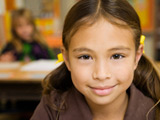
Standards Alignment
Lesson plans on ReadWriteThink are based on the IRA/NCTE Standards for the English Language Arts and also are aligned to individual state standards and, when applicable, to the Common Core State Standards (CCSS). These alignments were provided courtesy of a collaborative project between the Verizon Foundation and EdGate.
Common Core and State Standardsd
The Common Core adoption process is not considered final until the state has revised its high-stakes test for assessing these standards. During this process, ReadWriteThink will provide two subsets of alignments for the states (plus other entities) that have adopted the Common Core: one set to the state's current standards and one set to the CCSS. For states that have yet to adopt the CCSS, only one set of standards will be provided the state's current standards.
You may browse lessons and, upon finding one that meets your needs, select the Standards tab to see to which of your state's standards it aligns. In the first drop-down menu (Common Core State Standards) is a listing from which you can select your state's Common Core Standards version, if applicable. In the second drop-down (State Standards), states listed in the menu link to the state's official standards, which may include CCSS (states had the option of adopting Common Core "as is" or of adopting the Core with an additional 15% additions).
NCTE/IRA Standards for the English Language Arts
All ReadWriteThink lesson plans are based on the NCTE/IRA Standards for the English Language Arts. The International Reading Association and the National Council of Teachers of English have a shared purpose to ensure that all students are knowledgeable and proficient users of language so that they may succeed in school, participate as informed citizens, find challenging and rewarding work, appreciate and contribute to our culture, and pursue their own goals and interests as independent learners throughout their life.
The vision guiding these standards is that all students must have the opportunities and resources to develop the language skills they need to pursue life's goals and to participate fully as informed, productive members of society. These standards assume that literacy growth begins before children enter school as they experience and experiment with literacy activities—reading, writing, and associating spoken words with their graphic representations. Recognizing this fact, these standards encourage the development of curriculum and instruction that make productive use of the emerging literacy abilities that children bring to school. Furthermore, the standards provide ample room for the innovation and creativity essential to teaching and learning. They are not prescriptions for a particular curriculum or instruction.
For more information about the national standards, visit the IRA and NCTE websites.
- Students read a wide range of print and nonprint texts to build an understanding of texts, of themselves, and of the cultures of the United States and the world; to acquire new information; to respond to the needs and demands of society and the workplace; and for personal fulfillment. Among these texts are fiction and nonfiction, classic and contemporary works.
- Students read a wide range of literature from many periods in many genres to build an understanding of the many dimensions (e.g., philosophical, ethical, aesthetic) of human experience.
- Students apply a wide range of strategies to comprehend, interpret, evaluate, and appreciate texts. They draw on their prior experience, their interactions with other readers and writers, their knowledge of word meaning and of other texts, their word identification strategies, and their understanding of textual features (e.g., sound-letter correspondence, sentence structure, context, graphics).
- Students adjust their use of spoken, written, and visual language (e.g., conventions, style, vocabulary) to communicate effectively with a variety of audiences and for different purposes.
- Students employ a wide range of strategies as they write and use different writing process elements appropriately to communicate with different audiences for a variety of purposes.
- Students apply knowledge of language structure, language conventions (e.g., spelling and punctuation), media techniques, figurative language, and genre to create, critique, and discuss print and nonprint texts.
- Students conduct research on issues and interests by generating ideas and questions, and by posing problems. They gather, evaluate, and synthesize data from a variety of sources (e.g., print and nonprint texts, artifacts, people) to communicate their discoveries in ways that suit their purpose and audience.
- Students use a variety of technological and information resources (e.g., libraries, databases, computer networks, video) to gather and synthesize information and to create and communicate knowledge.
- Students develop an understanding of and respect for diversity in language use, patterns, and dialects across cultures, ethnic groups, geographic regions, and social roles.
- Students whose first language is not English make use of their first language to develop competency in the English language arts and to develop understanding of content across the curriculum.
- Students participate as knowledgeable, reflective, creative, and critical members of a variety of literacy communities.
- Students use spoken, written, and visual language to accomplish their own purposes (e.g., for learning, enjoyment, persuasion, and the exchange of information).